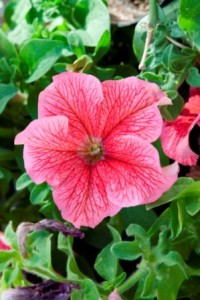Natural History of the Enigma

Eduardo Kac (US)
with his scientific partners Neil Olszewski, Department of Plant Biology and Neil Anderson, Department of Horticultural Science, University of Minnesota, St. Paul, MN
http://www.ekac.org
Golden Nica Hybrid Art
Installation
The central work is a plantimal, a new life-form that is not found in nature. The “edunia” is a genetically engineered flower that is a hybrid of the artist and a petunia. The edunia expresses the artist’s DNA in its red veins (through the production of a protein by a gene).
“The new flower is a petunia strain that I invented and produced through molecular biology. The edunia has red veins on light pink petals and a gene of mine is expressed in every cell of its red veins, i.e., my gene produces a protein only in the veins. The gene was isolated and sequenced from my blood. The pink background of the petals, against which the red veins are seen, is evocative of my own pinkish-white skin tone. The result of this molecular manipulation is a bloom that creates the living image of human blood rushing through the veins of a flower.
The gene I selected is responsible for the identification of foreign bodies. In this work, this is precisely what identifies and rejects the other that I integrate into the other, thus creating a new kind of self that is partially flower and partially human.
My IgG DNA is integrated into the chromosome of the edunia. This means that whenever the edunia is propagated through seeds my gene is present in the new flowers.
“Natural History of the Enigma” is a reflection on the contiguity of life between different species. It uses the redness of blood and the redness of the plant’s veins as a marker of our shared heritage in the wider spectrum of life. By combining human and plant DNA in a new flower in a visually dramatic way (red expression of human DNA in the flower veins), I demonstrate the contiguity of life between different species.
This work seeks to instill a sense of wonder in the public about this most amazing phenomenon we call “life”. The general public may have no difficulty in considering how close we truly are to apes and other non-human animals, particularly those with which it is possible to communicate directly, such as cats and dogs. However, the thought that we are also close to other life forms, including flora, will strike most people as surprising.
Eduardo Kac
